One of the rewards of doing time in a boatyard like Salt Creek Marina, in St. Petersburg, FL where Opal and I have been holed up, is the cast of intriguing characters and boats that pass through.
Earlier last month, a flatbed truck rolled in with a disassembled 40-foot performance cat that had been squeezed into a standard shipping container (roughly 40’ x 8’ x 8’). The high-tech performance cruising cat is the brainchild of Simon Angus, a boat-builder, sailor, and engineer based in Prince George, British Columbia. The sleek-looking craft is dubbed Whisper Dave, after Simon’s father. Angus’ design and manufacturing company is called Open Waters, and Whisper Dave is a prototype for a line of catamarans Open Waters hopes to produce.
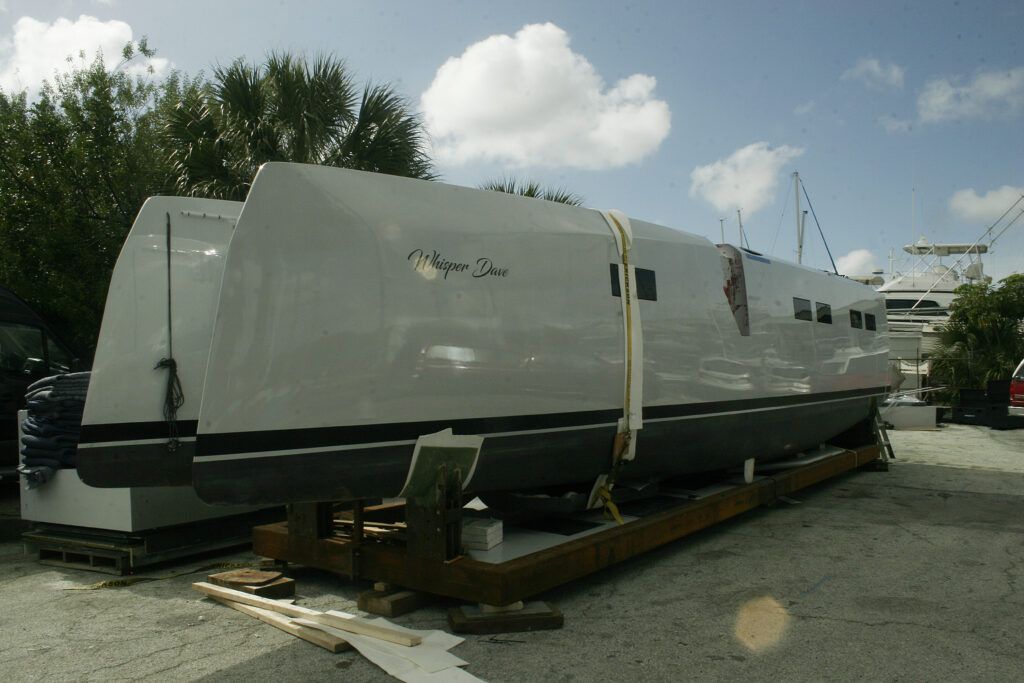
In the days that followed, the hulls’ open transoms disgorged nearly all of the components required to assemble a cruising catamaran. Two weeks later, the boat was in the water. This week, Angus was putting the finishing touches on the boat before a delivery to the Eastern Caribbean this month. Aside from some unfinished bits and pieces, all that remains to be done is the installation of twin Torqeedo pod drives that will provide auxiliary propulsion.
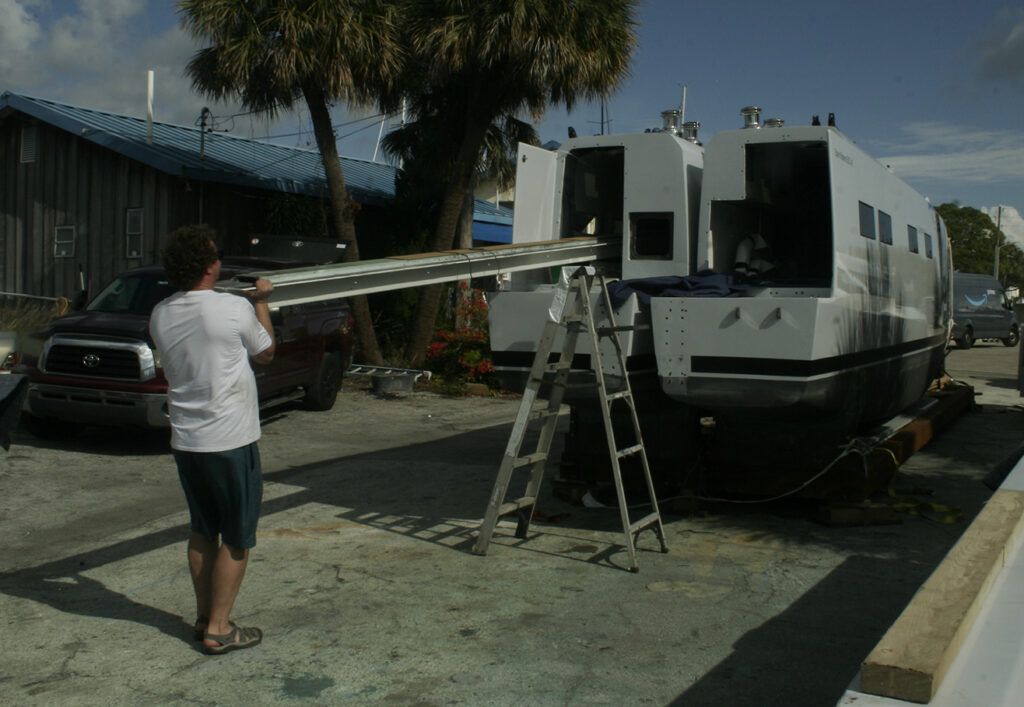
As we saw in our review of the Bob Perry-designed Far Harbor 39, a 39-foot monohull that slid into a standard shipping container, the advantage of a boat-in-a-box are self evident to the globe trotter who wants to travel far and wide without racking up the fees and wear and tear of delivery.
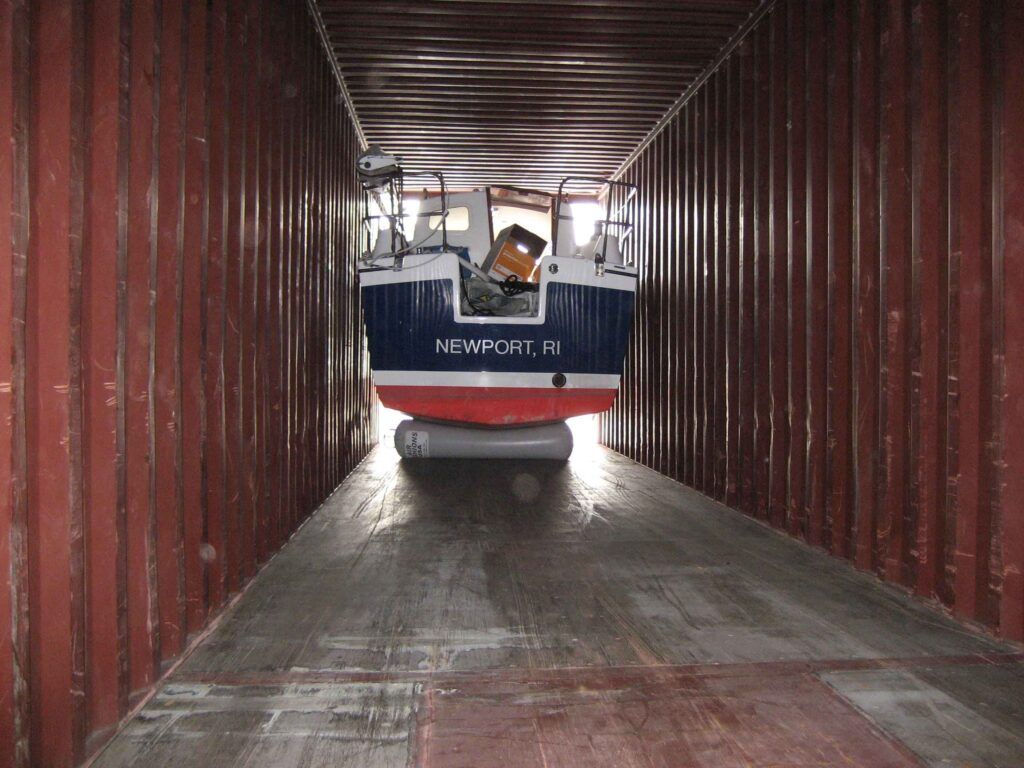
Before supply chain disruption drove up shipping costs, Angus’s boat could be delivered from British Columbia to the Caribbean and be assembled for about $8-10K (actual shipping costs are much less, but I am leaving a fair margin for assembly and yard expenses). We hope to dig some more into the design features of Whisper Dave in the future, but for the moment, I’ll focus on a detail that I thought our multihull fans would appreciate—although this system would be just as practical for the monohull sailor whose mainsheet (or traveler) is out of reach from the helm.
The Manual “Dump” Line
Many of our previous reports have explored the risks of multihull capsize and dismasting, and what sailors and designers are doing to reduce this risk. Recent incidents involving high-end performance catamarans rekindled the discussion of multihull pros and cons in Practical Sailor.
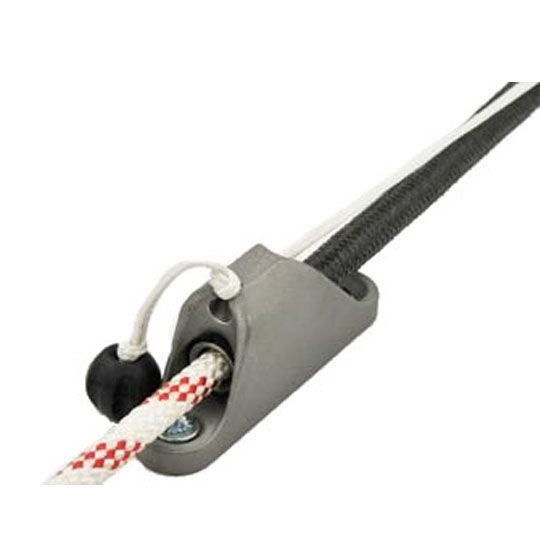
One detail that we did not explore in great depth in these reports were the mechanics of a “dump line,” which allows the helmsman (or automatic system) to quickly release the mainsheet in case the boat is overpowered. Angus has a manual release system that involves the clever use of Ronstan’s constrictor textile rope clutch and allows a person at the helm to quickly release the mainsheet with the sharp tug on a parachute cord.
Many of the essential lines on the Open Waters 40 are led to the helm and through Ronstan constrictor clutches (above). As we discussed in our rope clutch test, the Ronstan’s constrictor clutches—actually woven textile tubes—work like the old paper finger traps. When the clutch is in the grip mode, the textile tube constricts and grips the line. To release the grip, a quick tug on a high-strength parachute cord opens the constrictor tube, allowing the sheet or halyard to run freely.
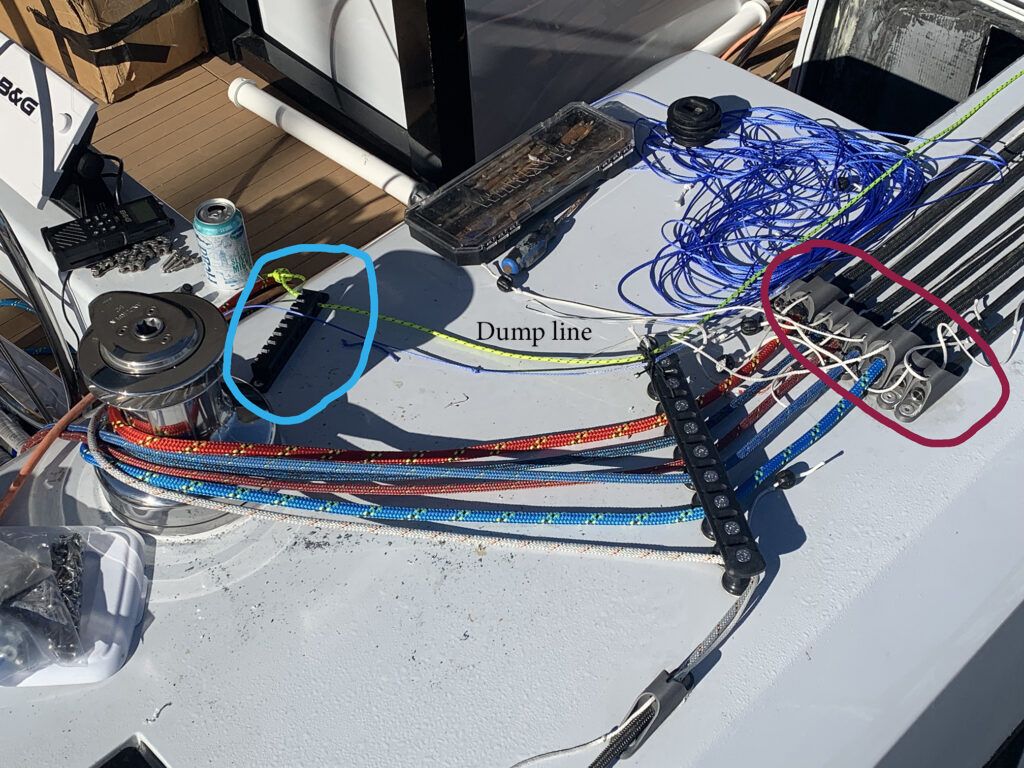
Angus likes the Ronstan constrictor clutches because of their simple design and because they don’t fray lines like traditional clutches can. He has also found he can “feather” the clutch to slowly ease a highly-loaded line without tearing any fibers (although it can get quite hot). Because the release mechanism is a thin parachute cord, rigging a remote release is fairly straightforward, just extend the constrictor release cord by attaching a longer cord to it. Angus used bright green parachute cord to serve as the remote release line.
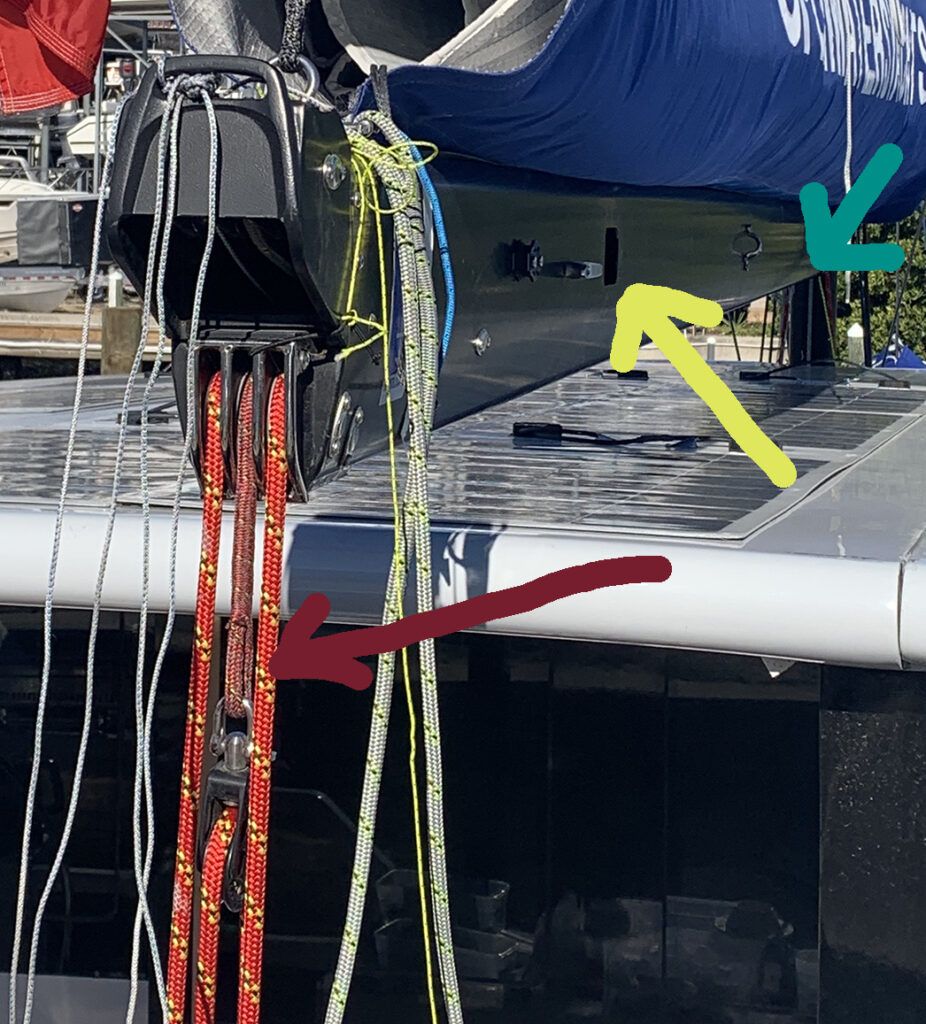
The photo above depicts the dump line setup on Whisper Dave. The Ronstan constrictor clutch is located inside the boom. Angus has a cut a port in the side of the boom so that constrictor clutch is accessible. Leading through the constrictor is the actual dump line. The dump line line attaches to a swivel bullet block at the boom end that is part of the mainsheet tackle. When the clutch is released, the dump line runs freely, dropping the block and easing tension on the mainsheet. It’s important that the dump line is long enough to adequately ease the mainsheet, and that all of the hardware sized to handle anticipated loads.
A ballpark cost of the setup on Whisper Dave is about $400, but a smaller boat could set up something similar for less. Hopefully, we’ll get the chance to try out the arrangement before the boat shoves off to the Caribbean next week.
































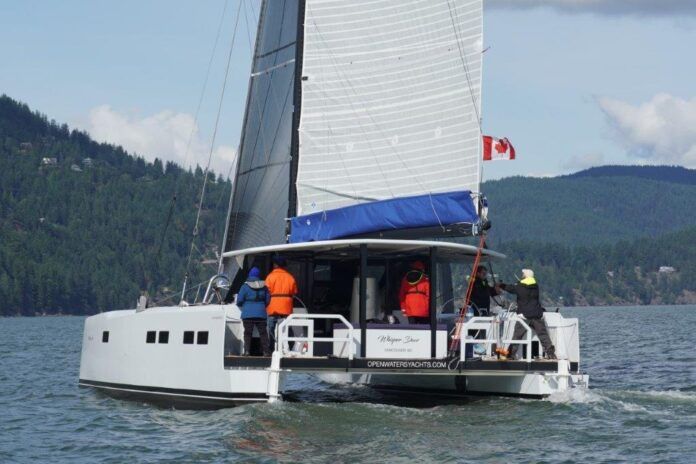





While I respect the credentials of you and others who use constrictors, etc on sheets- I feel you are over engineering and increasing risk.
When sailing in Tampa Bay, the main sheet on my Tartan 33 is held by a cam cleat mounted on the main sheet block. But offshore on deliveries I NEVER cleat, or clutch a sheet.
One of my standing orders for all watches is that the main and jib sheets are to be kept on winches. They are never clutched, cleated or otherwise restrained. If the need arises, remove the line from the self-tailer and take a wrap off an it will fly. Using a constrictor adds a failure point. If there is more than one constrictor, one has to grab the right one.
Obviously, when reefing or other times when a winch is needed, the sheet may be temporarily clutched. But once that operation is done, the sheet is returned to the winch.
Hello Darrell, Many thanks are due to you for bringing attention to the use of the Ronstan constrictor clutch for releasing halyards in emergent situations. In addition to depowering sails to prevent capsize of a multihull, I think the same can be employed to rapidly reduce the risk of knock-downs on any sailboat, particularly if it already has a Tides Marine Strong Track batten car system installed into the lug groove of the mast, allowing a mainsail to be dropped in an instant with release of the mainsail halyard. In this regard, depowering sails is crucial in mony man-overboard emergencies. I have often tried to
imagine a type of rope clutch that could be actuated remotely from a small diameter line attached to the D rings of a life vest harness. This could be the answer for significantly reducing loss of life, particularly for single-handed situations!
Instead of making ‘fast’ the (normally) anchored end of the mainsheet, I fed it around a pulley at the boom outer end, to another pulley inside the boom, with the ‘second mainsheet’ tied to the inner (gooseneck) end, back through the outer end pulley, back to the inner end exit to a deck cleat. The huge advantage is a ‘second release point’ while reefing or forward for some reason. IE. 5:1 normal, 10:1 fine tune, sounds complicated but works fine.
Hi Darrell, Like Capt Bill Herrmann we do not cleat the main sheet (nor headsail sheets) but leave it (them) on the self tailing winches. On our 38′ cat the main sheet winch is amidships on the transom and the helm is on starboard looking forward over the cabin roof. We simply re-orientated the mainsheet winch such that by simply pulling the sheet will fall out of the self tailer and the mainsheet will fly. This does mean that the main sheet is strung across the cockpit to the helm station but its not obtrusive as it is kept out of the way, lifted by bungy cord and a snatch block (that gives/stretches when you are in panic mode).
The need to dump the main for a cruising couple should really not be a fear – reefing down early is a more conservative approach. If the focus is maximising speed – then you should be working the mainsheet hands on and constantly trimming the sails in use – but that’s not commonly the focus of a cruising couple.
With regards to not cleating a sheet. I was also taught this when I learned to sail in 420’s. This is accomplished by physically hanging onto the sheets at all times. Good luck with that on a cruise – no one would do it as it would quickly become boring and tiring. The answer is the cam cleat on many main sheets and the self tailer on the jib sheets (circular clam cleats). In other words, pretty much everyone sails their cruising boat with the sheets cleated. Even when racing keel boats, the sheets spend time cleated, particularly the main sheet. The issue is the speed at which the sheet can be freed so that it can be dumped; on some boats, like mine, ease of access is the limiting factor (distance to the line control). I fail to see how opening a rope clutch is any slower than peeling a line out of a self tailer, and would argue it is safer as peeling line from a self tailer under load has to be done with care. If you can set up a sheet dump so that it is quicker to access, this is a win, as long as one does not leave the fast in a clutch and around self tailer at the same time.
It is clear from looking at the numerous videos on line, that a large proportion of multihull capsizes could be saved with an earlier release of the mainsheet. While the idea of keeping it uncleated in wild weather may sound theoretically safe, in the experience of many, its just not practical, as the loads are too high. But once cleated, experience shows that a high gust can add so much additional load that the line can be nigh impossible to manually release. The concept of an emergency release to the cleat as proposed by OpenWaters is certainly better than nothing and may work ‘more often than not’ but as the line STILL has to run through the now open clutch and blocks, Murphys Law will guarantee that too often, the meters of rope tail will jamb in a ball and foul up before the boom has gone far. As this issue requires serious study, I became involved in just that back in 2015 when two trimaran sailors I knew both got flipped when they could not release their mainsheets. Same happened to me in 2004 with a D25R but the ama ‘only’ went two feet under .. whew!
Since then, we have designed and built a new EMR (Emergency Mainsheet Release) that drops the complete mainsheet off the boom in 2 seconds with a Thump on a chest button, and we will be installing two of these “Thump’R” this summer for on-board testing, so stay in touch.
On my Corsair F242 trimaran, the mainsheet system attaches to the boom with a Wichard #411859 quick release snap shackle. I believe working load is +/-2000#. It works. The release lanyard is naturally out of conflict with reefing lines, sheets, etc. I like it because it is reasonably idiot-proof and misadventure-proof:
1. If I need to use it, I am likely already “leaning/falling” downward toward the mainsheet attachment point on the boom; also I have the taut mainsheet line assembly in hand to both guide and secure me while I reach for the lanyard.
2. Upon release, the boom flies free instantly and dumps its wind instantly, while the mainsheet assembly simply falls into the cockpit. This would be hazardous to whoever is standing downwind of the boom, but I cannot imagine an instance where one would be standing in this area in heavy weather.
3. I speak from experience. I’ve had this installed for 10 years, never had an accidental release and on the one occasion where everything went wrong (over-canvassed, under-crewed, traveling max speed, on autopilot, away from the helm, unseen/unexpected gust, and of course the mainsheet balled & jammed when I tried to release it) – in other words, during one of my IDIOT phases – the fitting popped open when I tugged the lanyard, the boom swung away, the hull(s?) dropped back down with a great splash, and the boat continued on course at a leisurely 10-ish knots under spinnaker alone while I sorted out the mess I had caused. It works.
I think its important to clarify that there’s such a large difference in the potential mainsheet loading of a multihull and a monohull (due mostly to the stability/heeling aspect) that I can fully understand why ‘Capt Bill’ is fine with a winched line. But as trimaraner Fred Cox points out, things can suddenly go into high power with a multihull, yet practical sailing of these boats absolutely demands that the highly loaded sheet be cleated. Sure, double ending a sheet with the added release ability as ‘BJ’ suggests is an improvement, but whenever such a release depends on a line running out through blocks or a clutch, the time will surely come when they WILL jam up. So our target is for a semi-automatic mainsheet release, but JUST for multihulls due to the high sheet loading …. something not typically required on a mono that sheds much of the pressure by heeling. When that sort of heeling occurs on a multihull, it’s generally too late! So what our device does is not unlike what Fred is doing manually, except that the skipper will have total control of when to release the boom, regardless of where he is on the boat … on the sprit, in the cabin or even up the mast! Trials will be conducted on trimarans of different size in both Australia and Europe, but until we have practical ‘at-sea’ feedback, it makes no sense to speculate on its success, even if our bench tests shown much promise. We will post results on http://www.smalltridesign.com until our new SeaSafetyTech site is up and running later in 2022. Safe sailing guys!
The tail-around-the-reverse-direction trick is neat, and I have used it countless times. But on every multi I have owned that had winches I have added another mechanism, that makes the sheeting like a dinghy. Simply take the tail out of the selftailer and place it in an dedicated cam cleat located between you and the winch. The release motion is instinctive, and it’s not an all-or-nothing dump, which puts a hell of a load on the rig. Think of the boom potentially slamming into the shroud, not unlike an accidental jibe. I would really hesitate to pull such a line. With a cam cleat, on the other hand, you can ease only what is needed, in control, like sailing a beach cat.
The load on the cam cleat will never be extreme, never more than the hand tailing tension. The load on a self tailor should never be more than hand tailing tension, or you need another turn on the winch. Release is not a problem, including times I have been flying a hull on a cruising cat (don’t do that–I was just playin’ on sheltered waters). Like sailing a really big, really expensive beach cat. The sail controls should be that good. They must be.
Jam the line? No more than a beach cat. The main sheet should always be flaked and ready to run. On big cats the line is winched, so the tackle has no more parts than a beach cat (3-6x) and not that much more line needs to run out.
Easy to grab a “dump line.” I think it is far more instinctive to remember where the cam cleat is, that you use all day, every day, and ease some line, than to remember to pull a dump line you have never used. At least that is the case for those of us that learned sailing small boats. For these sailors, lift and release under control is more instinctive than closing their eyes when they sneeze. Pulling a dump line requires conscious thought.
As for running the mainsheet through clutch on a multihull, I will be politically incorrect and say that is plain stupid. I feel the same way about all sheets. Each should have its own winch when in use, period. I am, in fact, appalled by the way most cruising cats emphasize cockpit appearance over sail handling. Too many clutches and too few winches.
And I think the cat-in-a-box idea is cool. I’d like to see more.
The semi-auto release idea is cool, but in my experience, that only protects against wind-only capsize on relatively flat waters, and that is not the scenario that scares experienced multihull drivers. You have to be really inattentive or inexperienced with tender mutihulls. at the helm. When waves become a factor, the situation that scares experienced multihull sailors, the problem is far more complex. For example, the boat is most likely off the wind (below the line of death) and mainsheet release might even make it worse.
Personally, I don’t think anyone should buy a multihull unless they’ve learned to fly a hull on a beach cat. They’ll be able to sail it, but they will never understand how they act when things go pear shaped until it happens to them, by which time it is far too late. And the lack of this experience explains nearly all mutihull capsizes (other than racing, when they knew they were pushing too hard–totally different) and probably all flat water capsizes.
But for sure, we want to see it! One of the biggest factors will be the ability to test the settings.
Fair points Drew, and we concur that there are times when you do NOT want to release the mainsheet. That is precisely why SeaSafetyTech (SST) has designed, (built and tested) a SEMI-automatic system that is 100% under the control of the Skipper.
In our opinion, we would also NOT want ‘release buttons scattered around the boat’ as some suggest, as this would be a significant additional hazard, where a flying boom could decapitate an innocent passenger down to leeward .. so an absolute ‘no-no’.
The SST Thump’R can ONLY be released by the skipper, but from wherever he/she is on the boat – as its operated by a chest worn button. NO calibration or adjustment of release load or heel angle is required as this device is either RELEASED or NOT .. being totally controlled by the skipper responsible – as we think it should be. Most of the capsizes now recorded in fairly high number on various YouTubes could be prevented with this device.
Write me at <> for more info if interested
I understand that many of the singled handed / short handed ocean racing multis use a hydraulic mainsheet (usually inside the boom). They have multiple “panic release” buttons positioned positioned around the boat in locations likely to be within reach of an on-watch crewmember. A number of the suggestions here appear to be efforts to approximate this using more conventional rigging.